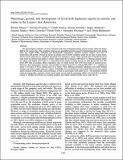Por favor, use este identificador para citar o enlazar a este item:
http://hdl.handle.net/10261/20334COMPARTIR / EXPORTAR:
 SHARE SHARE
 CORE
BASE CORE
BASE
|
|
| Visualizar otros formatos: MARC | Dublin Core | RDF | ORE | MODS | METS | DIDL | DATACITE | |

| Título: | Physiology, growth, and development of larval krill Euphausia superba in autumn and winter in the Lazarev Sea, Antarctica |
Autor: | Meyer, Bettina; Fuentes, Veronica CSIC ORCID; Guerra, Citlali; Schmidt, Katrin; Atkinson, Angus; Spahic, Susanne; Cisewski, Boris; Freier, Ulrich; Olariaga, Alejandro CSIC | Fecha de publicación: | sep-2009 | Editor: | American Society of Limnology and Oceanography | Citación: | Limnology and Oceanography 54(5): 1595-1614 (2009) | Resumen: | The physiological condition of larval Antarctic krill was investigated during austral autumn 2004 and winter 2006 in the Lazarev Sea. The condition of larvae was quantified in both seasons by determining their body length (BL), dry weight (DW), elemental and biochemical composition, stomach content analysis, and rates of metabolism and growth. Overall the larvae in autumn were in better condition under the ice than in open water, and for those under the ice, condition decreased from autumn to winter. Thus, growth rates of furcilia larvae in open water in autumn were similar to winter values under the ice (mean, 0.008 mm d21), whereas autumn underice values were higher (0.015 mm d21). Equivalent larval stages in winter had up to 30% shorter BL and 70% lower DW than in autumn. Mean respiration rates of winter larvae were 43% lower than of autumn larvae. However, their ammonium excretion rates doubled in winter from 0.03 to 0.06 mg NH4 DW21 h21, resulting in mean O:N ratios of 46 in autumn and 15 in winter. Thus, differing metabolic substrates were used between autumn and winter, which supports a degree of flexibility for overwintering of larval krill. The larvae were eating small copepods (Oithona spp.) and protozoans, as well as autotrophic food under the ice. The interplay between under-ice topography, apparent current speed under sea ice, and the swimming ability of larval krill is probably critical to whether larval krill can maintain position and exploit suitable feeding areas under the ice | Descripción: | 20 pages, 13 figures, 8 tables | Versión del editor: | https://doi.org/10.4319/lo.2009.54.5.1595 | URI: | http://hdl.handle.net/10261/20334 | DOI: | 10.4319/lo.2009.54.5.1595 | ISSN: | 0024-3590 |
| Aparece en las colecciones: | (ICM) Artículos |
Ficheros en este ítem:
| Fichero | Descripción | Tamaño | Formato | |
|---|---|---|---|---|
| Meyer_et_al_2009.pdf | 895,17 kB | Adobe PDF |  Visualizar/Abrir |
CORE Recommender
SCOPUSTM
Citations
67
checked on 21-abr-2024
WEB OF SCIENCETM
Citations
64
checked on 24-feb-2024
Page view(s)
427
checked on 24-abr-2024
Download(s)
323
checked on 24-abr-2024
Google ScholarTM
Check
Altmetric
Altmetric
NOTA: Los ítems de Digital.CSIC están protegidos por copyright, con todos los derechos reservados, a menos que se indique lo contrario.
